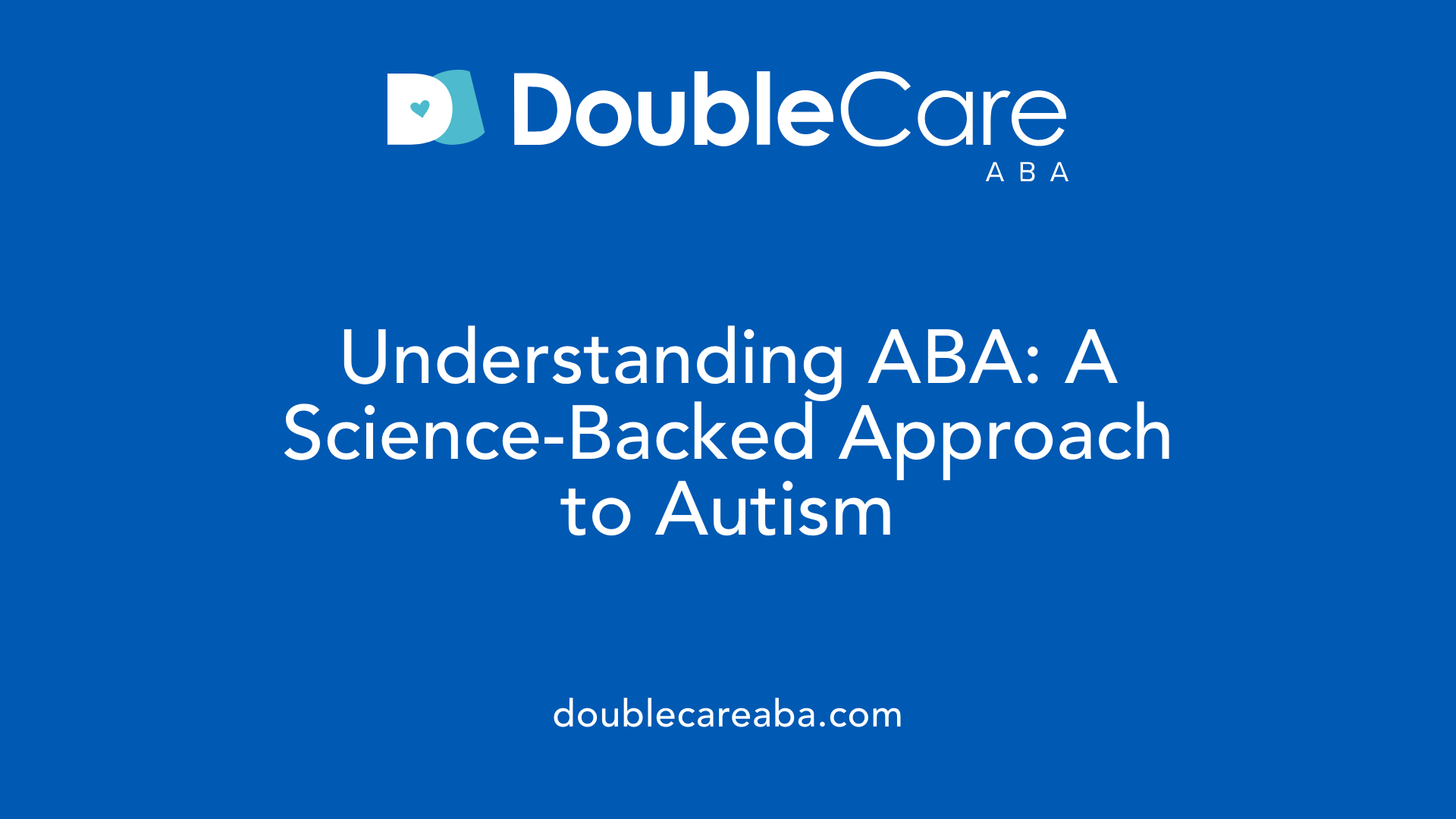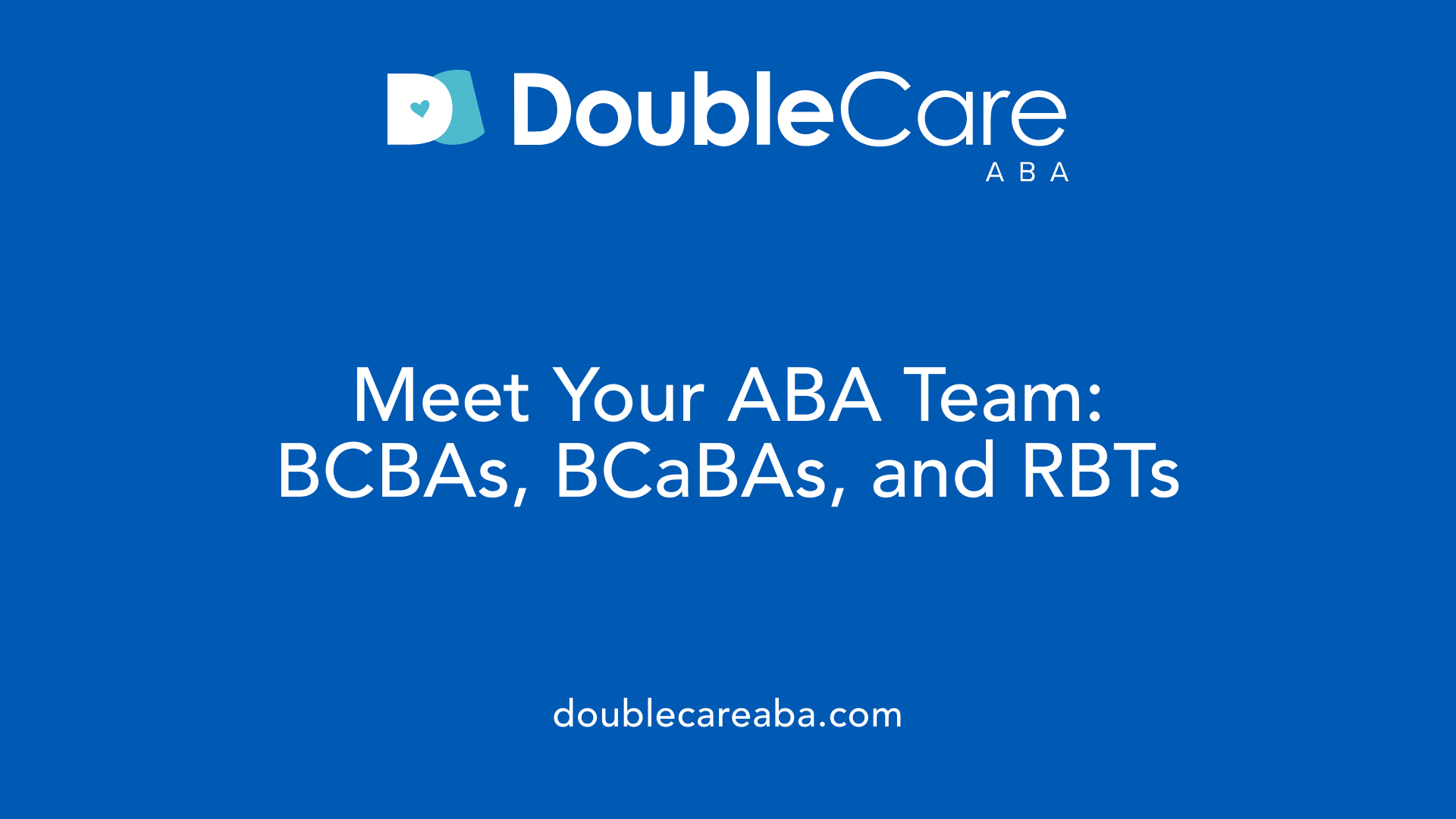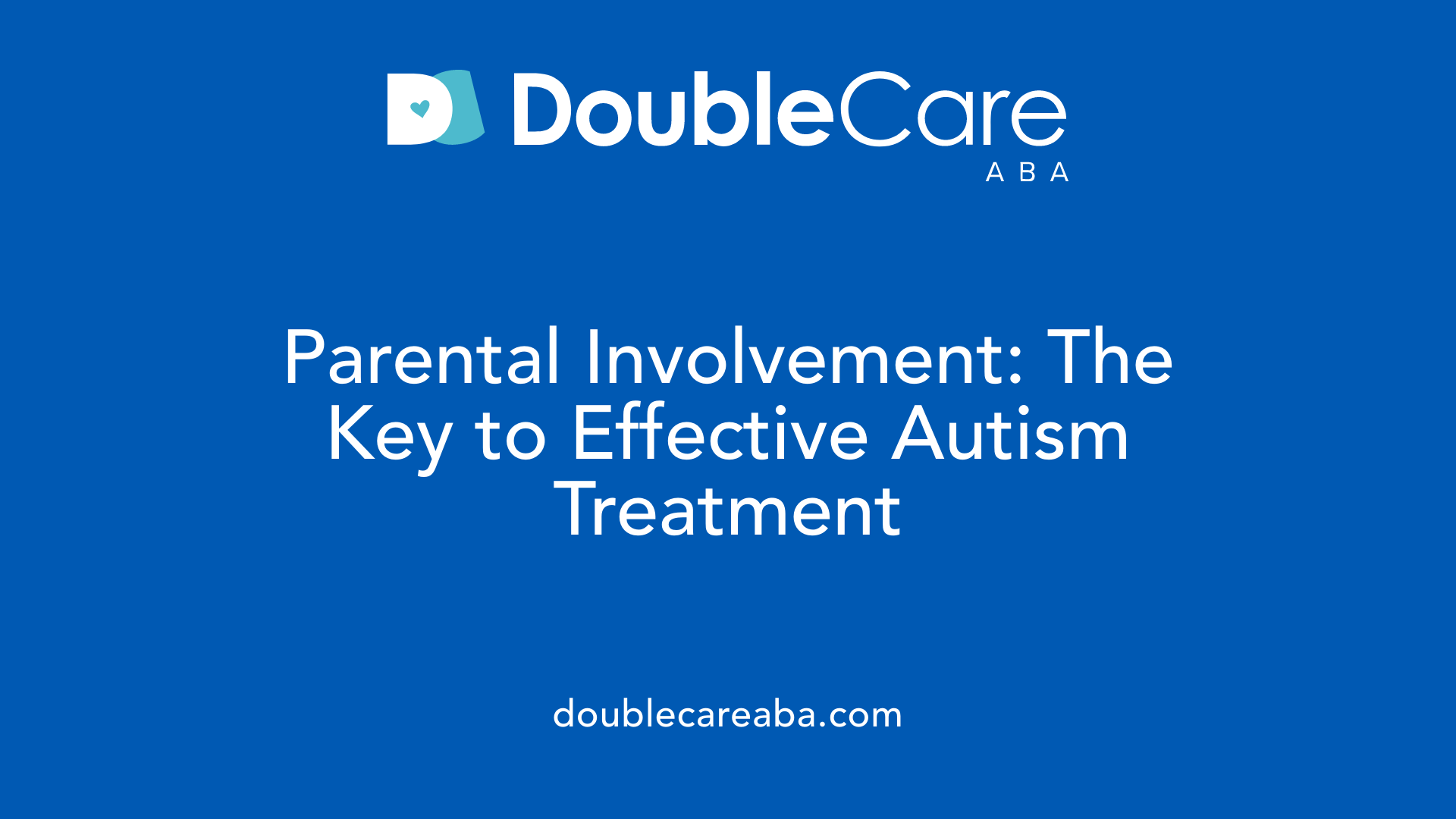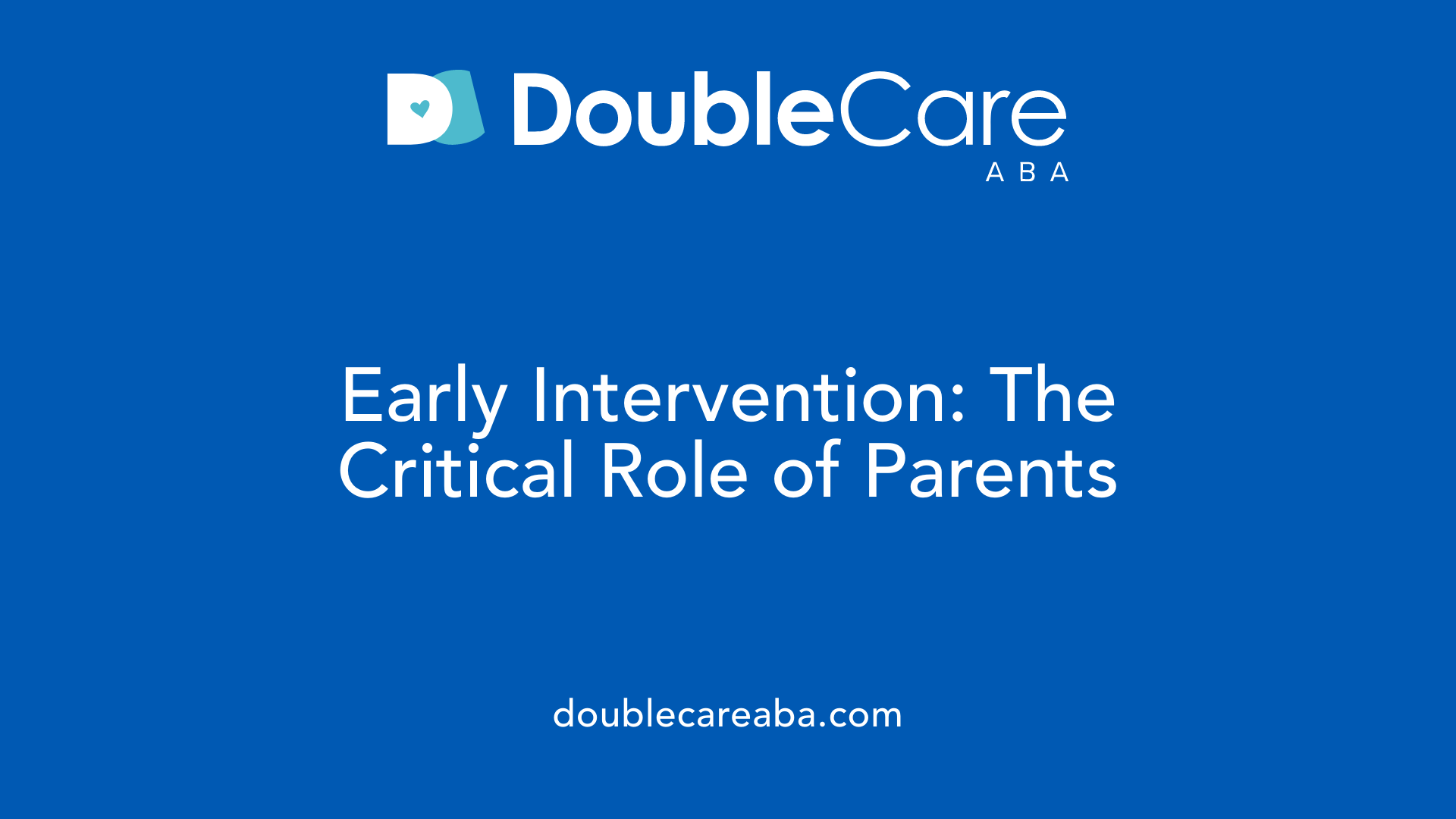Autism and Family Involvement in Therapy
Empowering Families: The Vital Role of Parents in Autism Therapy

Understanding ABA and Its Impact
Applied Behavior Analysis (ABA) therapy stands as a validated, science-based approach to autism treatment that substantially improves skills and reduces challenging behaviors. This article explores how parental involvement not only enriches the therapeutic process but also overcomes systemic barriers, leading to more effective outcomes for children with autism.
What is Applied Behavior Analysis (ABA) Therapy?

What is Applied Behavior Analysis (ABA) therapy?
Applied Behavior Analysis (ABA) therapy is a scientifically-supported approach that focuses on understanding and improving behaviors by leveraging principles of learning. It employs strategies like positive reinforcement, prompting, and the Antecedent-Behavior-Consequence (ABC) framework to encourage beneficial behaviors while reducing unfavorable ones.
ABA programs are highly tailored to each individual's needs, devised and overseen by qualified professionals such as Board Certified Behavior Analysts (BCBAs). These professionals select from various ABA methods, including Discrete Trial Training, Pivotal Response Treatment, and the Early Start Denver Model, to suit the individual's goals.
The core goals of ABA therapy involve enhancing a wide array of skills—communication, social interaction, attention, academic abilities, and adaptive behaviors. With autism spectrum disorder (ASD) being a primary focus, ABA strives to promote meaningful and sustainable improvements in developmental outcomes.
In essence, ABA is a structured and evidence-based treatment modality that empowers individuals, especially those with ASD, to acquire critical life skills and overcome behavioral challenges through customized intervention plans and ongoing professional oversight.
Benefits of ABA Therapy for Individuals with Autism

How does ABA therapy benefit individuals with autism?
Applied Behavior Analysis (ABA) therapy offers a comprehensive approach to teaching and reinforcing vital skills for individuals with autism. It targets areas such as communication, social interactions, daily living, and academic skills. By focusing on these, ABA helps individuals build independence and participate more fully in everyday life.
The therapy is grounded in scientific principles, utilizing methods like positive reinforcement and detailed analysis of behavioral triggers and consequences. This approach ensures that behavior changes are meaningful and lasting. ABA programs are carefully tailored to each person's unique needs and goals, designed by trained professionals, such as Board Certified Behavior Analysts (BCBAs).
Progress is continually monitored through systematic data collection, allowing adjustments to maximize effectiveness. This focus on outcomes enables improvements not only in reducing problematic behaviors but also in enhancing language and social skills. Through ABA, children with autism become better prepared for real-world situations, which supports their overall development and quality of life.
Early, intensive intervention using ABA has been linked to significant long-term benefits. Starting therapy young can lead to improved cognitive and developmental skills, laying a foundation for better academic achievement and social integration as children grow.
Involving parents in ABA therapy further enhances these benefits by ensuring consistency and reinforcement across home and community settings, fostering faster progress and empowering families to support their children's growth effectively.
Who Provides ABA Therapy?

Who typically provides Applied Behavior Analysis therapy?
Applied Behavior Analysis (ABA) therapy is delivered by a team of skilled professionals including Board Certified Behavior Analysts (BCBAs), Assistant Behavior Analysts (BCaBAs), and Registered Behavior Technicians (RBTs).
Roles of BCBAs, BCaBAs, and RBTs
BCBAs, holding at least a master's degree, are responsible for designing the treatment plans, conducting assessments, and supervising the therapy process. BCaBAs assist BCBAs and provide therapy under their guidance. RBTs are trained paraprofessionals who implement ABA interventions with clients, following prescribed protocols.
Training and qualifications of providers
RBTs complete specific training and certification, while BCBAs and BCaBAs undergo rigorous coursework, supervised fieldwork, and exams. This tiered structure ensures quality and consistency in treatment delivery.
Settings where ABA is delivered
ABA therapy is flexible and can be provided in various settings such as homes, schools, clinics, and community centers to best meet individual needs.
Diagnostic requirements and insurance coverage
Typically, a formal autism spectrum disorder (ASD) diagnosis from a qualified professional is required to start ABA therapy. Most insurance providers cover ABA when it is deemed medically necessary, making treatment accessible to many families.
Common ABA Techniques Proven Effective

What techniques are commonly used in ABA therapy?
Applied Behavior Analysis (ABA) therapy employs a variety of techniques to encourage positive behavior changes and skill development in individuals, particularly those with autism spectrum disorder (ASD).
One widely used method is positive reinforcement, where a rewarding stimulus is given following a desired behavior to increase its future occurrence. Conversely, negative reinforcement works by removing an unpleasant stimulus when the desired behavior occurs, thus encouraging that behavior.
Discrete Trial Training (DTT) is another core technique. It involves breaking down skills into small, manageable steps that are taught systematically with clear instructions and immediate reinforcement. This structured approach is effective for teaching new skills.
Meanwhile, Natural Environment Teaching (NET) integrates learning opportunities into everyday routines and real-life settings, helping individuals generalize skills outside of formal sessions.
Other approaches include behavior chaining, which breaks complex tasks into a sequence of simpler steps that are taught progressively. Prompting techniques guide the learner toward the correct response, with gradual fading of prompts to promote independence.
Modeling allows the learner to observe and imitate desired behaviors demonstrated by therapists or caregivers. Finally, extinction involves withholding reinforcement for undesired behaviors to reduce or eliminate them.
These techniques are applied flexibly depending on each learner's unique needs and are backed by extensive research validating their effectiveness in producing meaningful and lasting behavior change.
Measuring and Monitoring Progress in ABA Therapy

Continuous data collection
Progress in ABA therapy is tracked through ongoing data collection, which allows therapists to monitor changes in the child's behavior and skill set over time. This includes recording occurrences of targeted behaviors and new skills as they develop.
Assessment tools and baseline evaluations
Before therapy begins, assessments such as Functional Behavior Assessments and skill evaluations help establish a clear baseline for each child's abilities. These tools guide the creation of personalized treatment goals across various domains including communication, social skills, cognition, and self-care.
Tracking skill development and behavior changes
As therapy progresses, clinicians regularly analyze collected data to measure improvements in adaptive behaviors and reductions in interfering behaviors. This continuous tracking helps to evaluate treatment effectiveness and make necessary adjustments.
Generalization of skills
An important measure of success in ABA therapy is the generalization of learned behaviors beyond therapy sessions. This means children can apply new skills consistently in different environments such as home and community settings.
Role of parents in progress monitoring
Parents play a crucial role in monitoring progress by providing consistent support and reinforcement outside formal therapy sessions. Their involvement enables additional practice opportunities and helps ensure that the child's development extends into everyday life. Collaborative communication between parents and behavior analysts strengthens goal alignment and facilitates timely adjustments to treatment plans.
Progress measurement in ABA is thorough and multifaceted, ensuring that gains are meaningful and sustained. Celebrating each achievement, no matter how small, helps maintain motivation and creates a personalized approach to supporting children with autism spectrum disorder.
The Crucial Role of Parental Involvement in Autism Therapy

Parental Involvement as a Core Component of ABA Effectiveness
Applied behavior analysis (ABA) therapy is most effective when parents play an active role. Parental involvement is essential to delivering consistent, reinforced treatment that supports children's developmental progress. Programs like Forta’s parent behavior technician (pBT) model exemplify this by training parents rigorously and integrating them in treatment delivery under expert supervision.
Providing Consistent Support Across Different Environments
One major benefit of involving parents is the ability to extend therapy beyond clinical settings into daily home and community life. With parent-led ABA, children receive continual reinforcement of learned skills in natural environments, helping behaviors to generalize effectively and become part of everyday routines.
Enhancing Therapy Outcomes Through Collaboration
Research shows that when parents collaborate with Board Certified Behavior Analysts (BCBAs) and attend training sessions, children exhibit significant improvements in adaptive behaviors and reductions in interfering behaviors. Moreover, parents gain confidence and self-efficacy, which translates into accelerated progress for their children.
Bridging Therapy and Home Life
Active parental participation bridges the gap between formal therapy and real-world application. Through open communication, caregiver-guided sessions, and collaborative goal-setting, families and professionals align on objectives and maintain ongoing progress monitoring. This partnership empowers parents to manage their child’s needs effectively and supports consistent skill practice outside therapy hours.
Parent Behavior Technician Model: Overcoming Barriers with Family-Led Treatment

Forta’s pBT model overview
Forta has innovated a Parent Behavior Technician (pBT) model that equips parents to deliver applied behavior analysis (ABA) treatments directly to their children under the guidance of behavior analysts. This strategy aims to tackle common obstacles limiting access to ABA therapy, including workforce shortages, logistical complexities, and high treatment costs.
Training parents as behavior technicians
Parents undergo rigorous training to become proficient behavior technicians capable of administering ABA interventions effectively. This training empowers families to actively engage in their child’s therapeutic process, enhancing outcomes and fostering confidence.
Use of proprietary technology and supervision
Integral to the pBT model is Forta’s proprietary technology, which enables precise treatment monitoring and data collection. Ongoing clinical supervision by Board Certified Behavior Analysts (BCBAs) ensures that therapy remains high quality, adjustments are timely, and parents receive continuous professional support.
Addressing workforce shortages, logistics, and costs
By devolving treatment delivery to trained parents, the pBT model mitigates workforce limitations and reduces logistical barriers such as travel and scheduling conflicts. It also lowers overall costs by minimizing reliance on direct therapist hours. This approach increases accessibility, particularly benefiting children with severe ASD and significant interfering behaviors who require intensive therapy.
This innovative model demonstrates that leveraging family members as key treatment agents can expand ABA reach, improve clinical outcomes, and make autism interventions more sustainable and inclusive.
Clinical Outcomes and Improvements from Family-Involved ABA Therapy

How Do Vineland-3 Scores Reflect Improvements in ABA Therapy?
A study measuring clinical outcomes using Vineland-3 scores showed that children aged 3 to 15 years experienced significant gains in adaptive behaviors following over three months of family-involved ABA treatment. These improvements indicate enhanced communication, socialization, and daily living skills vital for children with autism spectrum disorder (ASD).
What Reductions in Interfering Behaviors Are Observed?
Alongside adaptive skills, there was a marked reduction in interfering behaviors (IBs)—such as repetitive or self-injurious actions—that can hinder learning and social interaction. This emphasizes the effectiveness of the parent behavior technician (pBT) model in addressing both skill acquisition and behavior management.
Does Severity of Autism Impact Treatment Outcomes?
Children with more severe ASD symptoms and clinically significant interfering behaviors demonstrated higher treatment utilization and greater clinical improvements. This suggests that increased family involvement through the pBT model can produce meaningful progress even in more challenging cases.
How Does Treatment Utilization Affect Outcomes and Accessibility?
Higher treatment utilization correlated with better outcomes across multiple developmental domains. The accessibility of the parent-led model allows families to engage in more therapy hours than traditionally prescribed, thereby enhancing the dosage and consistency of ABA treatment. This model also helps overcome typical barriers such as workforce shortages and logistical challenges, broadening access to effective care.
How Parental Involvement Accelerates Child Progress

Additional Practice and Reinforcement
Parental involvement in ABA therapy allows children with autism to receive more frequent practice outside formal sessions. Parents trained in ABA techniques can consistently apply learned strategies at home, offering children opportunities to reinforce and build on new skills. This consistent reinforcement is crucial for consolidating learning and accelerating developmental progress.
Generalizing Skills Across Settings
One major advantage of involving parents is the ability to generalize children's learned behaviors beyond the therapy setting. Skills practiced at home with parent guidance transfer more effectively to other environments, such as the community or school. This cross-setting application ensures that children can use adaptive behaviors in real-life situations, enhancing the overall effectiveness of treatment.
Home and Community Support
Parents provide continuous support, creating a stable and familiar environment that complements clinical interventions. Their active role ensures that therapeutic gains are not isolated to clinical settings but are supported within daily routines. This integrated support system promotes sustained improvements in adaptive function and reduces interfering behaviors.
Faster Achievement of Goals
By engaging parents as active participants, treatment goals are pursued more intensively and consistently. This partnership between parents and professionals aligns efforts, producing faster progress. Studies have shown that parent-led models of ABA correlated with significant improvements in adaptive behaviors within a few months, highlighting that empowered parents contribute directly to their child's accelerated development.
Collaboration Between Parents and ABA Professionals

Improved Communication and Goal Alignment
Collaboration between parents and applied behavior analysis (ABA) professionals fosters improved communication, which is essential for effective treatment. By working together, parents and Board Certified Behavior Analysts (BCBAs) can align on goals specific to the child’s needs, ensuring that interventions are tailored and consistent across settings.
Sharing Progress and Challenges
Regular sharing of progress and challenges allows both parties to adjust strategies and respond proactively. Parents provide valuable insights into the child’s behavior at home and in community settings, complementing clinical observations. This continuous two-way communication supports timely modifications, optimizing treatment outcomes.
Ongoing Supervision and Feedback
Ongoing supervision by BCBAs plays a critical role in guiding parents who deliver ABA treatment. This oversight not only ensures adherence to protocols but also helps parents refine techniques based on clinical feedback. The use of proprietary technology for monitoring treatment enhances this process, facilitating real-time data sharing and evaluation.
Empowering Parents Through Education
Parental empowerment is a cornerstone of successful ABA therapy. Through rigorous training and education, parents gain confidence and skills to implement interventions effectively. This empowerment reduces stress, increases self-efficacy, and promotes consistent practice that extends beyond formal therapy sessions, accelerating the child's developmental progress.
Parental Training and Empowerment in ABA Therapy

Training methods and caregiver-guided sessions
In parent-led ABA therapy models, such as Forta’s Parent Behavior Technician (pBT) approach, parents receive rigorous training to deliver ABA treatment effectively. This training often includes caregiver-guided sessions that involve collaboration between parents and Board Certified Behavior Analysts (BCBAs), ensuring proper technique and goal alignment. Proprietary technology supports treatment monitoring, while ongoing clinical supervision ensures fidelity to protocols.
Parent confidence and self-efficacy gains
Studies have demonstrated significant increases in parental self-efficacy when parents are actively engaged in implementing ABA. Parents participating in parent-led ABA programs report growing confidence in applying therapeutic strategies, unlike those in practitioner-led models who showed little change. This boost in self-efficacy empowers parents to manage their child's interventions more effectively.
Reduction of parental stress
Parental stress, historically high among caregivers of children with autism spectrum disorder, shows reduction through participation in parent training. As self-efficacy rises, an inverse relationship leads to lower stress levels. These reductions enhance the overall family environment, providing a more supportive atmosphere for the child's progress.
Supporting management of child's needs
Engaging parents as active therapy participants allows them to better understand their child's diagnosis and treatment goals. This collaboration improves communication with professionals and enables consistent reinforcement across home and community settings. Training equips parents with the tools and confidence needed to manage their child's needs, fostering generalization of learned behaviors and accelerating developmental gains.
Types and Strategies of Parental Involvement

Parent Training Sessions
Parent training is a foundational element in ABA therapy, equipping caregivers with the skills and knowledge to implement treatment strategies effectively. These sessions cover techniques for managing behaviors and teaching new skills, enabling parents to become confident partners in their child's therapy.
Collaborative Goal Setting
Meaningful parental involvement includes working alongside ABA professionals to set and adjust therapy goals. This collaboration ensures that objectives are realistic, relevant, and tailored to the child’s unique needs, promoting shared understanding and consistent implementation.
Home-Based Therapy Applications
Delivering ABA strategies within the home environment allows for greater reinforcement of learned behaviors across daily routines. Parents apply the techniques learned during training sessions, providing consistent practice opportunities that accelerate developmental progress.
Strategies: Communication, Observation, Practice
Effective parental involvement thrives on open communication between families and clinicians. Attending training, actively observing therapy sessions, and applying learned strategies at home are essential. These practices foster a continuous feedback loop, empowering parents and improving outcomes by reinforcing skills in natural settings.
Impact of Parent-Led ABA on Parental Self-Efficacy and Stress

How does parent-led ABA increase parental confidence?
Parent-led ABA involves parents implementing ABA techniques with oversight from certified behavior analysts. Studies reveal that this model significantly increases parental self-efficacy. Parents engaged in parent-led ABA showed a statistically significant rise in confidence scores over time. This improved confidence helps them feel more capable and effective in managing their child's therapy and everyday needs.
What is the relationship between parental self-efficacy and stress?
Research identifies an inverse relationship between parental self-efficacy and stress levels. Specifically, higher parental confidence is associated with lower stress. Since parents of children with ASD often experience notably high stress, boosting their self-efficacy through involvement in ABA can help alleviate these pressures.
How does parent training affect parental stress?
Incorporating parent training into ABA not only elevates confidence but also reduces stress. Active participation and education empower parents to better understand their child's diagnosis, approach therapy consistently, and manage behavioral challenges more effectively. These aspects contribute to notable stress reduction.
What are the broader benefits of reducing parental stress?
Lower parental stress and greater self-efficacy positively impact overall family well-being. When parents feel equipped and less overwhelmed, they can provide more consistent support across home and community settings. This alignment contributes to better therapy outcomes and a healthier family environment where both children and caregivers thrive.
The Importance of Parental Involvement in Early Intervention Success

Early Teaching and Structured Intervention
Parental involvement is a fundamental factor in the success of early intervention programs for children with autism. When parents consistently engage in teaching their child at home alongside structured early intervention services, children demonstrate notable gains in cognitive and developmental skills. This dual approach harnesses the strengths of both professional guidance and everyday learning opportunities.
Cognitive and Developmental Improvements
Children receiving active parental teaching combined with formal intervention exhibit accelerated progress. Structured support from therapy sessions is reinforced through parent-led activities, boosting the child's developmental trajectory more effectively than therapy alone.
Generalization of Learned Behaviors
One critical advantage of parental involvement is helping children generalize their newly acquired skills beyond clinical settings. Consistent parental teaching at home promotes the transfer and maintenance of behaviors learned during therapy into real-world environments such as family and community contexts.
Sustaining Therapy Gains Beyond Clinical Settings
Sustaining therapy outcomes requires ongoing practice and reinforcement. Parents trained to implement ABA strategies provide continuous support, allowing skills to be maintained and strengthened over time. This ongoing caregiver participation fosters consistency, which is vital for long-term success in autism treatment.
Challenges to Effective Parental Involvement

What are the major barriers to effective parental involvement in ABA therapy?
Parental involvement is crucial for the success of applied behavior analysis (ABA) therapy in children with autism. However, several challenges can impede this involvement. One of the most significant barriers is high parental stress. Parents of children with autism spectrum disorder (ASD) often experience heightened stress levels, which can negatively affect their capacity to participate actively in therapy. This stress can derive from managing their child's complex needs, behavioral difficulties, and the emotional toll of caregiving.
Additionally, socioeconomic factors play a considerable role. Limited financial resources, lack of access to transportation, and inflexible work schedules can restrict parents' ability to attend training sessions or therapy appointments. Without appropriate support, these socioeconomic hurdles hinder consistent parental engagement.
How do lack of support and education affect parental involvement?
Another critical challenge is insufficient education and support for parents. When parents lack adequate knowledge about ASD and ABA techniques, they may feel ill-prepared or overwhelmed, reducing their confidence and willingness to implement therapeutic strategies at home. The absence of ongoing guidance and training can widen the gap between professional intervention and everyday family practices.
This educational deficit also hampers collaboration between professionals and parents. Without clear communication and shared goals, children's progress may plateau due to inconsistent application of therapy principles across settings.
What impact do these challenges have on the effectiveness of ABA therapy?
When parental involvement is limited by stress, education gaps, or lack of support, therapy effectiveness can diminish. ABA relies heavily on consistency and practice beyond formal sessions. If parents are unable or unwilling to reinforce learned skills at home, children may struggle to generalize improvements to their natural environments, slowing developmental gains and behavioral improvements.
Moreover, disconnects between parents and professionals can reduce the accuracy of progress monitoring and timely adjustments to treatment plans, further impacting outcomes.
What strategies can help overcome these challenges?
To enhance parental involvement, several strategies can be implemented:
- Providing comprehensive training: Structured parent training equips families with the necessary skills and knowledge to confidently implement ABA techniques.
- Enhancing communication: Open, ongoing dialogue between therapists and parents fosters collaboration and ensures goal alignment.
- Offering flexible support: Utilizing telehealth, home-based sessions, or parent-led models like Forta's parent behavior technician approach can alleviate logistical burdens.
- Addressing parental stress: Integrating stress-reduction resources and peer support groups can empower parents and improve their well-being.
By acknowledging and addressing these challenges, ABA programs can better engage families, optimize therapy effectiveness, and promote sustained developmental progress in children with ASD.
Consequences of Limited Parental Involvement

Disconnect Between Therapy and Home
When parents are not actively involved in their child's ABA therapy, a significant gap can form between the therapeutic setting and the home environment. This disconnect makes it challenging for professionals to ensure that skills learned during therapy sessions are appropriately reinforced outside of those sessions. Without consistent parental support, children may struggle to apply new behaviors in daily life.
Difficulty Supporting Skill Generalization
One hallmark of effective autism intervention is the generalization of learned skills across multiple settings. Limited parental involvement hampers this generalization process because parents play a crucial role in consistently practicing and reinforcing techniques at home. Without this continual reinforcement, learned behaviors may not fully transfer, reducing the long-term impact of therapy.
Reduced Child Progress
Studies emphasize that children receiving consistent parental teaching alongside structured early interventions demonstrate greater cognitive and developmental gains. Conversely, a lack of parental engagement often results in slower progress or stagnation. This diminished progress can be particularly detrimental for children with more severe ASD or interfering behaviors, where frequent practice and reinforcement are essential.
Importance of Family-Professional Alliance
Collaborative relationships between families and ABA professionals are vital for aligning goals, monitoring progress, and adapting strategies. Limited parental involvement weakens this alliance, reducing communication and making it harder to tailor interventions to the child's evolving needs. In contrast, active family involvement empowers parents, lowers stress, and enhances treatment outcomes, benefiting both the child and family dynamics.
By understanding these consequences, stakeholders can prioritize fostering meaningful parental involvement to maximize the benefits of ABA therapy for children with autism.
Fostering Family Engagement: Best Practices from ABA Providers

How do education and training offerings support parental involvement?
Effective ABA providers prioritize educating parents through rigorous training programs. These trainings empower parents with the skills needed to implement ABA techniques confidently, as exemplified by Forta's parent behavior technician model. By equipping parents with hands-on knowledge, they become active participants in therapy, enhancing consistency and reinforcement beyond clinical settings.
What approaches encourage collaborative goal setting?
Collaboration between parents and ABA professionals is foundational to successful interventions. Providers like Strive ABA Consultants employ joint goal-setting strategies, ensuring that treatment objectives align with family priorities and daily routines. This joint process fosters ownership, improves communication, and facilitates progress monitoring tailored to each child's unique needs.
How is open communication maintained between families and providers?
Open lines of communication are vital for sustaining engagement and adjusting treatment plans effectively. ABA programs encourage regular dialogue through scheduled meetings, progress updates, and accessible support channels. This approach helps address concerns promptly and create a positive partnership that supports the child's development.
In what ways does supportive technology enhance family involvement?
The use of proprietary technology for treatment monitoring, as seen in Forta's model, enables real-time tracking of therapy delivery and outcomes. Technology facilitates remote supervision of parent-led sessions by certified behavior analysts, allowing families greater accessibility and flexibility. This innovation removes logistical barriers, supports treatment fidelity, and fosters continuous collaboration between parents and professionals.
Together, these best practices form a comprehensive framework that strengthens family engagement in ABA therapy, ultimately improving outcomes for children on the autism spectrum.
Looking Ahead: The Future of Family-Involved ABA Therapy

Expanding parent-led models
Parent-led applied behavior analysis (ABA) is gaining momentum as a promising solution to the workforce shortages, logistical challenges, and cost barriers in autism therapy. Programs like Forta's parent behavior technician (pBT) model demonstrate the potential for parents to effectively implement ABA techniques under the supervision of certified behavior analysts (BCBAs). As these models prove their efficacy, wider adoption across therapy providers is expected, enabling more families to access personalized support.
Technological innovations
The integration of proprietary technology platforms plays a crucial role in the scalability and quality assurance of family-involved ABA. These tools facilitate real-time tracking of treatment progress, remote supervision by clinicians, and data-driven adjustments tailored to each child's needs. Advances in telehealth and mobile applications will further empower parents, making treatment monitoring and communication with professionals more accessible and seamless.
Policy and accessibility improvements
Looking forward, policy frameworks are likely to evolve to support parent-led therapy models through better funding, insurance coverage, and training resources. Recognizing the value of parental involvement in treatment outcomes may drive reforms aimed at reducing systemic barriers. Enhanced accessibility, especially for families in underserved or rural areas, will be critical to equitable intervention delivery.
Sustaining empowered family roles in therapy
Sustaining the progress made in parent-led ABA depends on continuous education, collaborative goal setting, and open communication between families and practitioners. By fostering parental self-efficacy, programs can reduce stress and increase confidence, thus improving treatment fidelity and long-term outcomes. Encouraging ongoing parent participation and feedback loops will ensure that therapy remains adaptive and family-centered.
The future of ABA therapy lies in these synergistic advances, where empowered parents, innovative technology, supportive policies, and teamwork drive improved outcomes for children with autism and their families.
Family-Centered Autism Therapy: A Path Forward
Parental involvement in Applied Behavior Analysis therapy is more than a supportive component—it is fundamental to successful treatment outcomes for children with autism. Models like Forta's parent behavior technician approach exemplify how empowering families with training, resources, and collaboration can overcome traditional barriers such as access and cost. As research continues to demonstrate, engaged and confident parents can accelerate progress, generalize skills effectively, and reduce stress, creating a more holistic and sustainable path for their children’s development. Moving forward, strengthening family-professional partnerships and integrating innovative technologies will be crucial in making family-centered autism therapy accessible and effective for all.
References
- Family-Centric Applied Behavior Analysis Facilitates ...
- The Importance of Parental Involvement in ABA Therapy
- Effectiveness of Parent-Led Applied Behavior Analysis at ...
- The Role of Caregiver Involvement in ABA Therapy
- Applied Behavior Analysis (ABA)
- Applied Behavior Analysis (ABA)
- What Is Applied Behavior Analysis (ABA)?
- ABA Therapy Examples, Definition & Techniques
- ABA Techniques: Strategies for Behavior Analysts - GSEP Blog
















